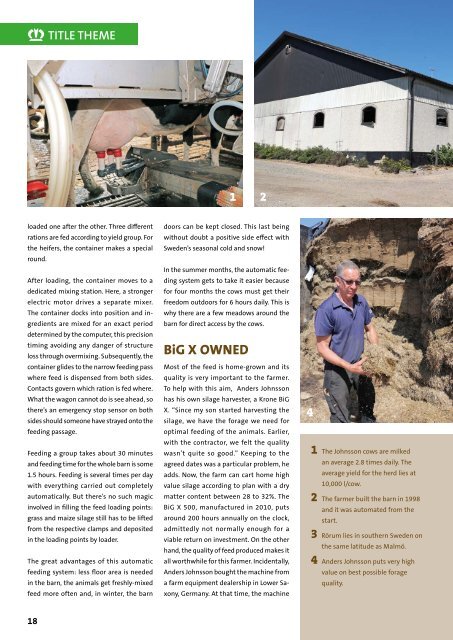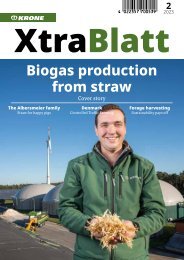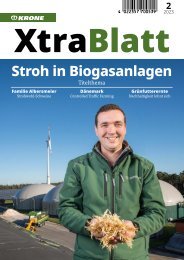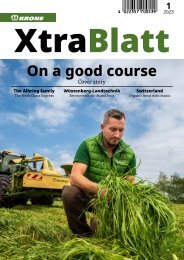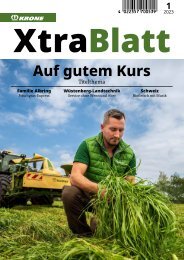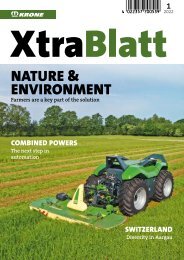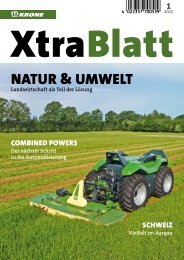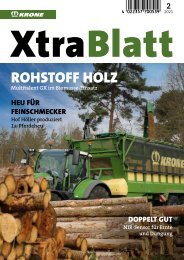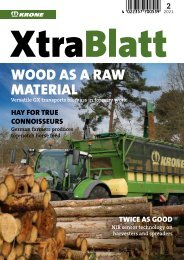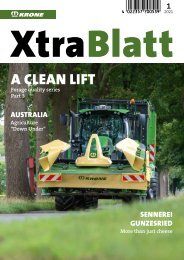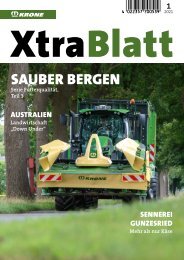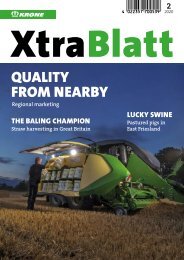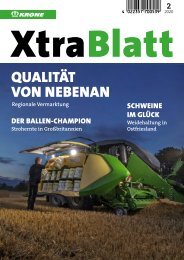XtraBlatt Issue 01-2019
You also want an ePaper? Increase the reach of your titles
YUMPU automatically turns print PDFs into web optimized ePapers that Google loves.
TITLE THEME<br />
Rörum<br />
1 2<br />
3<br />
loaded one after the other. Three different<br />
rations are fed according to yield group. For<br />
the heifers, the container makes a special<br />
round.<br />
After loading, the container moves to a<br />
dedicated mixing station. Here, a stronger<br />
electric motor drives a separate mixer.<br />
The container docks into position and ingredients<br />
are mixed for an exact period<br />
determined by the computer, this precision<br />
timing avoiding any danger of structure<br />
loss through overmixing. Subsequently, the<br />
container glides to the narrow feeding pass<br />
where feed is dispensed from both sides.<br />
Contacts govern which ration is fed where.<br />
What the wagon cannot do is see ahead, so<br />
there’s an emergency stop sensor on both<br />
sides should someone have strayed onto the<br />
feeding passage.<br />
Feeding a group takes about 30 minutes<br />
and feeding time for the whole barn is some<br />
1.5 hours. Feeding is several times per day<br />
with everything carried out completely<br />
automatically. But there’s no such magic<br />
involved in filling the feed loading points:<br />
grass and maize silage still has to be lifted<br />
from the respective clamps and deposited<br />
in the loading points by loader.<br />
The great advantages of this automatic<br />
feeding system: less floor area is needed<br />
in the barn, the animals get freshly-mixed<br />
feed more often and, in winter, the barn<br />
doors can be kept closed. This last being<br />
without doubt a positive side effect with<br />
Sweden’s seasonal cold and snow!<br />
In the summer months, the automatic feeding<br />
system gets to take it easier because<br />
for four months the cows must get their<br />
freedom outdoors for 6 hours daily. This is<br />
why there are a few meadows around the<br />
barn for direct access by the cows.<br />
BiG X OWNED<br />
Most of the feed is home-grown and its<br />
quality is very important to the farmer.<br />
To help with this aim, Anders Johnsson<br />
has his own silage harvester, a Krone BiG<br />
X. “Since my son started harvesting the<br />
silage, we have the forage we need for<br />
optimal feeding of the animals. Earlier,<br />
with the contractor, we felt the quality<br />
wasn’t quite so good.” Keeping to the<br />
agreed dates was a particular problem, he<br />
adds. Now, the farm can cart home high<br />
value silage according to plan with a dry<br />
matter content between 28 to 32%. The<br />
BiG X 500, manufactured in 2<strong>01</strong>0, puts<br />
around 200 hours annually on the clock,<br />
admittedly not normally enough for a<br />
viable return on investment. On the other<br />
hand, the quality of feed produced makes it<br />
all worthwhile for this farmer. Incidentally,<br />
Anders Johnsson bought the machine from<br />
a farm equipment dealership in Lower Saxony,<br />
Germany. At that time, the machine<br />
4<br />
1 The Johnsson cows are milked<br />
an average 2.8 times daily. The<br />
average yield for the herd lies at<br />
10,000 l/cow.<br />
2 The farmer built the barn in 1998<br />
and it was automated from the<br />
start.<br />
3 Rörum lies in southern Sweden on<br />
the same latitude as Malmö.<br />
4 Anders Johnsson puts very high<br />
value on best possible forage<br />
quality.<br />
AGRICULTURE IN SWEDEN Source: Jordbruksstatistik Sammanställning 2<strong>01</strong>8<br />
Areas<br />
Farmland<br />
Arable<br />
Pasture<br />
Forest<br />
Farms<br />
had around 1000 h work behind it. “In<br />
normal years, we can manage three cuts of<br />
grass silage”, he explains. For the cows, the<br />
grass is ensiled in clamps while the calves<br />
get round bale silage. A Krone machine<br />
also does the mowing: an Easy Cut 870 CV<br />
butterfly combination.<br />
On the whole, the farm is highly mechanised<br />
for its 300 ha. Standing ready in the<br />
machinery shed are six tractors up to 350<br />
HP. The farm owns a large slurry tanker and<br />
a dung spreader. Alongside the BiG X 500<br />
there’s a farm-owned combine harvester<br />
and round baler.<br />
3,032,000 ha<br />
2,580,000 ha<br />
452,000 ha<br />
3,326,000 ha<br />
Number of farms 63,000<br />
Of which full time 15,500<br />
Average farm size<br />
Livestock production<br />
41 ha<br />
Number of farms with cattle 16,300<br />
Dairy farms 3,600<br />
Milking cows 322,<strong>01</strong>0<br />
Average herd<br />
89 cows<br />
Pig production<br />
Pig breeding<br />
Average herd size<br />
Pig feeding<br />
Feeding pigs over 20 kg<br />
Average feeding pig unit<br />
Yields<br />
Winter wheat average<br />
Winter oilseed rape<br />
Ware potatoes<br />
Sugar beet<br />
Farm machinery<br />
The most important crop and feed base for<br />
the cows is grass grown on around 120 ha.<br />
Further crops include 30 ha winter wheat<br />
and a good 25 ha of spring barley. To exploit<br />
the silage harvester capacity a bit further<br />
and bring more energy into the rations, the<br />
farm grows 54 ha forage maize, chopping<br />
to around 20 mm, although chop length<br />
depends on forage dry matter. Important<br />
for this farmer is a well consolidated silage<br />
clamp so that the forage remains stable<br />
through the summer and doesn’t reheat.<br />
Summary. “Everything aimed at milk production<br />
with maximum digitization.” This<br />
1,300 farms<br />
800 farms<br />
165 head<br />
1,100 farms<br />
836,000 head<br />
825 places<br />
7.36 t<br />
3.43 t<br />
30.84 t<br />
63.2 t<br />
New tractors sold 2.800<br />
Average power of new tractors<br />
147 HP<br />
could well be the motto for the Johnsson<br />
Aspekulle Farm in southeast Sweden. In<br />
the barn, the herd is not only monitored<br />
by computer and milked by robots; the<br />
computer takes over control of feeding<br />
too, with a feed container gliding through<br />
the cattle accommodation on overhead<br />
rails. Human hands are only involved in<br />
transporting feed to the automatic loading<br />
points. And if the human touch fails to<br />
deliver even that on time, a computer<br />
alarm is given. Naturally automatically!<br />
The ultimate benefit: this farmer and his<br />
helpers have much more time to keep a<br />
close eye on the cows. «<br />
18 19


